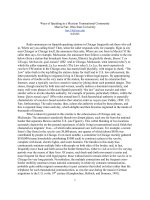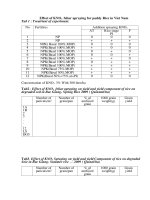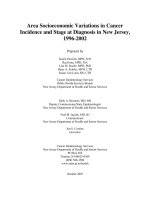Tài liệu Faultlines of Conflict in Central Asia and the South Caucasus - Implications for the U.S. Army docx
Bạn đang xem bản rút gọn của tài liệu. Xem và tải ngay bản đầy đủ của tài liệu tại đây (762.86 KB, 152 trang )
FUTURE
ROLES
OF U.S.
NUCLEAR
FORCES
FUTURE
ROLES
OF U.S.
NUCLEAR
FORCES
Implications for U.S. Strategy
GLENN C. BUCHAN
DAVID MATONICK
CALVIN SHIPBAUGH
RICHARD MESIC
R
Project AIR FORCE
Prepared for the United States Air Force
Approved for public release; distribution unlimited
RAND is a nonprofit institution that helps improve policy and
decisionmaking through research and analysis. RAND
®
is a
registered trademark The views expressed in this report are those of
the authors and do not reflect the official policy or position of the
Department of Defense or the United States Air Force.
© Copyright 2003 RAND
All rights reserved. No part of this book may be reproduced in any
form by any electronic or mechanical means (including
photocopying, recording, or information storage and retrieval)
without permission in writing from RAND.
Library of Congress Cataloging-in-Publication Data
Future roles of U.S. nuclear forces : implications for U.S. strategy / Glenn Buchan
[et al.].
p. cm.
Includes bibliographical references.
MR-1231-AF
ISBN 0-8330-2917-7
1. Strategic forces—United States. 2. United States—Military policy. 3. Nuclear
weapons—United States. I. Buchan, Glenn C.
UA23 .F883 2000
355.02'17'0973—dc21
00-045817
Cover design by Tanya Maiboroda
The research reported here was sponsored by the United States Air
Force under Contract F49642-01-C-0003. Further information may
be obtained from the Strategic Planning Division, Directorate of
Plans, Hq USAF.
Published 2003 by RAND
1700 Main Street, P.O. Box 2138, Santa Monica, CA 90407-2138
1200 South Hayes Street, Arlington, VA 22202-5050
201 North Craig Street, Suite 202, Pittsburgh, PA 15213-1516
RAND URL: />To order RAND documents or to obtain additional information,
contact Distribution Services: Telephone: (310) 451-7002;
Fax: (310) 451-6915; Email:
iii
PREFACE
This study examines the possible roles of nuclear weapons in con-
temporary U.S. national security policy. Since the end of the Cold
War, the United States has been reexamining its basic assumptions
about foreign policy and various instruments of national security
policy to define its future needs. Nowhere is such an examination
more important than in the nuclear arena.
Research for this document was completed in the summer of 2000
and, therfore, predates the current administration's Nuclear Posture
Review. A lengthy governmental clearance and public release review
process has resulted in the 2003 publication date of this formal
report.
A lot has happened since then. The Bush administration has com-
pleted its NPR, which is classified, although much of it has been
leaked to the press. The United States has conducted a war against
Iraq, which it rationalized primarily on the grounds that Iraq was be-
lieved to be developing weapons of mass destruction (i.e., chemical
and biological weapons in the near term; nuclear weapons in the
long term). The United States also faces a confrontation with North
Korea, which claims to have already developed a few nuclear
weapons and threatens to make more, and Iran, which U.S. intelli-
gence believes has a covert nuclear weapons program. The Bush
administration has also announced plans to develop a new genera-
tion of nuclear weapons, improved earth penetrators with small-
yield warheads to destroy underground facilities more effectively.
The Bush administration has signed a new arms reduction treaty
with Russia (i.e., the Moscow Treaty). It has also withdrawn from the
iv Future Roles of U.S. Nuclear Forces: Implications for U.S. Strategy
Antiballistic Missile (ABM) Treaty and announced its intention to
deploy a National Missile Defense (NMD) system to protect the
United States from attacks by rogue states. This report does not
consider any of these specific events, although it does cover all the
relevant general topics. Updating the report would amount to doing
a whole new study, so we chose to release the report in its original
form. The general analysis is still relevant and should inform any
future debate on future U.S. nuclear strategy.
Futher, discerning readers will note a few locations in the text where,
for reasons of classification, the authors have been forced to sidestep
the historical record, and we beg the reader's indulgence for these
instances. While they produce some distortion in facts as presented,
they do not affect the basic analysis contained here. On balance, we
judged that broader interests were served by the wide distribution of
a slightly imperfect unclassified document, rather than more limited
distribution of a classified report that would be more accurate in a
narrow, technical sense.
This work should be of interest to those involved in nuclear strategy,
force planning, arms control, and operational planning. The work
was conducted in Project AIR FORCE’s Strategy and Doctrine
Program, which was directed by Dr. Zalmay Khalilzad at the time we
did the work. Subsequently, Dr. Ted Harshberger succeeded Dr.
Khalilzad as director of the Strategy and Doctrine Program. The
project leader was Dr. Glenn Buchan.
PROJECT AIR FORCE
Project AIR FORCE (PAF), a division of RAND, is the Air Force feder-
ally funded research and development center for studies and analy-
ses. PAF provides the Air Force with independent analyses of policy
alternatives affecting the development, employment, combat readi-
ness, and support of current and future aerospace forces. Research is
performed in four programs: Aerospace Force Development;
Manpower, Personnel, and Training; Resource Management; and
Strategy and Doctrine.
Additional information about PAF is available on our web site at
/>v
CONTENTS
Preface iii
Figures xi
Tables xiii
Summary xv
Acknowledgments xxiii
Acronyms xxv
Chapter One
INTRODUCTION 1
Chapter Two
NUCLEAR WEAPONS AND U.S. SECURITY—BACK TO
BASICS 3
What Nuclear Weapons Do 3
Risks and Disadvantages of Nuclear Weapons 5
The Historical Legacy 7
Chapter Three
CONTEMPORARY ROLES FOR U.S. NUCLEAR
WEAPONS 13
The New Security Environment 13
Future Nuclear Threats 14
Other Kinds of Threats 24
U.S. National Security Policy: A Spectrum of
Possibilities 33
Abstinence 33
Defense 35
vi Future Roles of U.S. Nuclear Forces: Implications for U.S. Strategy
Counterforce and Countermilitary Operations 36
Deterrence and Coercion 37
Potential Roles for U.S. Nuclear Weapons 38
Terror Weapons/Traditional Deterrence 39
Counterforce 41
Special Targets 43
Critical Military Situations 44
Chapter Four
STRESSING CASES: SOME CONTEMPORARY
COMPARISONS BETWEEN NUCLEAR AND
CONVENTIONAL WEAPONS 47
Strategic Nuclear Weapons in Halting Invading Armies 48
Halting an Army: Nuclear Weapons 49
Halting an Army: Smart/Brilliant Weapons 50
Halting an Army: Collateral Damage Possibilities 51
Halting an Army: Pros and Cons of Nuclear Versus
Conventional Weapons 55
Strategic Nuclear Weapons in Destroying Hardened
Bunkers Containing WMD 59
Destroying Bunkers: Nuclear Weapons 60
Destroying Bunkers: Conventional Precision-Guided
Weapons 61
Destroying Bunkers: Advantages and Disadvantages of
Nuclear and Conventional Weapons 61
Destroying Bunkers: “New” Weapons? 62
Strategic Nuclear Weapons in Destroying a Deeply Buried
Command and Control Facility 62
Destroying Deeply Buried Facilities: Earth-Penetrating
Conventional Weapons 63
Destroying Deeply Buried Facilities: Nuclear
Weapons 64
Destroying Deeply Buried Facilities: Collateral
Damage 69
Destroying Deeply Buried Facilities: Nuclear Versus
Conventional Weapons for Functional Kills 70
Role of Nuclear Weapons in Defense Against Ballistic
Missiles 71
Missile Defense: Nuclear Weapon Performance 72
Nuclear Threat 73
Biological Threat 74
Contents vii
Missile Defense: Collateral Damage 76
Missile Defense: Nuclear Delivery Options 79
Comparison: The Four Scenario Classes 80
Chapter Five
IMPLICATIONS FOR FUTURE U.S. NUCLEAR
STRATEGY 83
A Spectrum of Nuclear Strategic Options 83
Abolition 84
Aggressive Reductions and “Dealerting” 86
“Business as Usual, Only Smaller” 92
A More Aggressive Nuclear Posture 92
Nuclear Emphasis 94
Some Additional Comments on Deterrence by Threat of
Punishment 94
Maintaining a Robust Nuclear Deterrent 96
Flexible Use of Nuclear Forces 100
Characteristics of Nuclear Weapon Systems 105
Exploiting Asymmetries 106
Nuclear Proliferation 107
Is “Withering Away” Inevitable? 109
Chapter Six
CONCLUSIONS 113
References 121
ix
FIGURES
3.1. Hierarchy of Approaches to Dealing with Future
Conflicts 34
3.2. Why the United States Might Want Nuclear Weapons
in the Contemporary World 40
4.1. Thermal Radiation Versus Ground Range for 1-kT
Weapon 52
4.2. Thermal Radiation Versus Ground Range for 10-kT
Weapon 53
4.3. Thermal Radiation Versus Ground Range for 100-kT
Weapon 53
4.4. Thermal Radiation Versus Ground Range for 1000-kT
Weapon 54
4.5. Peak Overpressure Versus Depth for 1-kT Warhead 64
4.6. Peak Overpressure Versus Depth for 10-kT Warhead . 65
4.7. Peak Overpressure Versus Depth for 100-kT
Warhead 65
4.8. Peak Overpressure Versus Depth for 1000-kT
Warhead 66
4.9. Peak Overpressure Versus Depth for 100-kT Warhead
in Porous Rock 67
4.10. Peak Overpressure at Depth and Range for 100-kT
Contact Burst 68
4.11. Peak Overpressure at Depth and Range for 100-kT
Warhead Detonated 2 m Below Rock Surface 69
4.12. Fallout Dose Versus Downwind Range 70
4.13. Fallout Dose Versus Downwind Range (Vertical Axis
Expanded to Show Fallout from Higher-Yield
Weapons) 71
x Future Roles of U.S. Nuclear Forces: Implications for U.S. Strategy
4.14. Neutron Kill Range Against a Ballistic Missile with a
Biological Warhead 76
4.15. Parametric X-Ray Kill Range Against Commercial
Satellites 78
5.1. What Constitutes a “Robust” Nuclear Deterrent? 97
5.2. Traditional Types of “Hedge” Responses to Maintain a
Robust Force 98
5.3. Why the “School Solution” Might Be Inadequate . . . or
Even Wrong 99
5.4. How Using the Wrong “World Model” Could Lead to
Erroneous Robustness Criteria for Nuclear Forces 100
5.5. But These Problems May Not Require Nuclear
Responses 101
xi
TABLES
2.1. Targets for Which Nuclear Weapons Are Particularly
Suitable 4
3.1. A Scorecard for Evaluating Nuclear-Armed
Opponents 18
xiii
SUMMARY
The defining characteristic of nuclear weapons—their almost unlim-
ited destructive power—makes them unmatched as terror weapons
and potentially more effective than any other type of weapon in
strictly military terms (i.e., destroying targets). Moreover, the ability
to produce nuclear weapons with relatively large yields in very small
packages can dramatically increase their potential military value.
Accordingly, nuclear weapons offer a range of strategic and tactical
advantages to those countries that possess them. They can be used
as instruments to
• coerce enemies by threat or actual use
• deter enemies from a range of actions by threat of punishment
• offset an imbalance of conventional forces
• fight a large-scale war
• destroy specific critical installations
• enhance national prestige and win a “place at the table” in the
international arena.
The United States has used its nuclear forces for most of those pur-
poses. Even more significant, it has not used them in combat since
Nagasaki. Most notably, of course, the United States used nuclear
weapons to coerce the Japanese to surrender in World War II and
later maintained a large nuclear arsenal to deter the Soviet Union
from launching a nuclear attack on the United States or invading
Western Europe with its numerically superior conventional forces.
xiv Future Roles of U.S. Nuclear Forces: Implications for U.S. Strategy
The United States also tried, with mixed success, to extract additional
political mileage from brandishing its nuclear forces in peripheral
conflicts.
The distinctive nature of the Cold War shaped the evolution of U.S.
nuclear strategy and force structure in important ways. The domi-
nant threat to the United States was the Soviet Union, an ideological
adversary and competing great power armed with nuclear weapons
that posed a direct threat to the United States after the Soviets devel-
oped long-range missiles and armies that appeared capable of over-
whelming the conventional forces of U.S. allies in Western Europe.
Once the Soviet Union developed intercontinental ballistic missiles
(ICBMs) and submarine-launched ballistic missiles (SLBMs) armed
with nuclear warheads, there was no way to protect the United States
from a Soviet nuclear attack. After the Soviets deployed their missiles
on nuclear ballistic missile submarines (SSBNs) and in hardened si-
los, disarming them with a nuclear first strike would have been vir-
tually impossible, although the United States never stopped trying to
develop the requisite technical capabilities. As a result, the best way
to prevent a Soviet nuclear attack on the United States appeared to
be to deter such an attack by threatening retaliation with U.S. nu-
clear weapons.
Implementing that deterrence strategy shaped U.S. strategic forces
and operating practices in critical ways that affect U.S. forces to this
day:
• A mix of ICBMs, SLBMs, and bombers—the so-called “triad”—
was chosen in the 1950s to provide a diverse enough force to
complicate an attacker’s problem in trying to destroy the entire
force and to hedge against technical failures of various sorts.
• A set of tactical warning systems and an associated network of
command and control systems and procedures was developed to
detect and characterize an impending nuclear attack on the
United States, identify the attacker, and provide senior U.S. poli-
cymakers with at least a few minutes to respond to an attack be-
fore the system broke down.
• U.S. strategic forces were maintained at very high levels of alert—
bombers on strip alert, SSBNs at sea, and ICBMs ready to launch
within a few minutes—to minimize the effect of a surprise attack.
Summary xv
• U.S. weapons were pretargeted and integrated into a single mas-
sive plan—the Single Integrated Operational Plan (SIOP)—with a
few variants to make execution of a retaliatory strike as simple,
quick, and efficient as possible.
For its success, this approach depended to some degree on historical
and geographic accidents:
• The time and space that separated the principal antagonists
• The time to develop and perfect intercontinental nuclear forces
on both sides
• The relatively unique nature of those forces
• The relative simplicity of the largely bipolar world.
Although these factors helped reduce the stress and fog of the U.S
Russian nuclear confrontation, it was still very dangerous. Because of
the stakes in the competition (e.g., national survival), both sides were
willing to take substantial risks—accidental or unauthorized
launches, mistakes, miscalculations—to reduce their vulnerability to
surprise attacks. Because of the sheer destructiveness of nuclear
weapons, any mistake could have had catastrophic consequences.
Everyone recognized that fact from the beginning and tried to take
steps to reduce the dangers, but the perceived need to deter a delib-
erate nuclear attack took precedence.
The end of the Cold War changed a lot, but not everything:
• The dissolution of the Soviet Union and the Warsaw Pact greatly
diminished the chances of general nuclear war or a major war in
Europe. U.S. and Russian relations, while not exactly cordial
since the post–Cold War “honeymoon” ended, are much less
confrontational than in the past.
• U.S. and Russian nuclear forces are much smaller and operate at
lower levels of alert. Still, Russian strategic nuclear forces remain
the only current threat to the national existence of the United
States. In addition to the overt threat, Russian economic woes;
the deterioration of some of its nuclear forces, command and
control and warning systems, and nuclear infrastructure; and the
general failure of Russian economic and political reforms pose
xvi Future Roles of U.S. Nuclear Forces: Implications for U.S. Strategy
new kinds of problems for U.S. security (e.g., nuclear theft, pro-
liferation, and unauthorized use) and exacerbate old ones (e.g.,
war by accident or mistake).
• U.S. strategic nuclear forces are structured basically the same
way they have always been. (U.S. tactical nuclear forces have
largely been eliminated.) U.S. operational procedures have in
the main changed little since the Cold War days.
• Nuclear proliferation is probably a greater problem now than it
was during the Cold War. The odds of nuclear use by someone
somewhere have probably increased.
• There may be more nuclear players and different types of players
with different concepts of nuclear strategy and means of deliver-
ing weapons. That situation could make defending against or
deterring nuclear use more difficult.
• Faced with U.S. military and economic dominance, other nations
and nonstate actors are likely to seek different ways to counter
U.S. power (e.g., terrorism, covert use of nuclear or biological
weapons).
• Political instability in established nuclear states is a cause of
major concern. An established nuclear power coming unglued
and lashing out is the worst possible threat to U.S. security for the
foreseeable future.
The United States is currently facing this world with a set of nuclear
forces that is only a somewhat reduced version of the force it has
maintained for decades. Similarly, its overall strategy is virtually the
same—the only real difference is an explicit nuclear threat against
countries developing biological and chemical weapons.
We found that the United States has a much broader range of nuclear
strategies and postures among which it could choose, including at
least
• abolition of U.S. nuclear weapons
• aggressive reductions and “dealerting”
• “business as usual, only smaller”
Summary xvii
• more aggressive nuclear posture
• nuclear emphasis.
“Mixing and matching” is also possible. For example, a much
smaller nuclear force operated differently could also be used more
aggressively if the situation demanded it.
Devising a U.S. nuclear strategy for the future requires a mix of ana-
lytical assessments and value judgments. Among our key observa-
tions are the following:
• Nuclear weapons still lend themselves best to deterrence by
threats of punishment, although one can never be certain how
effective such threats will be. Even small nuclear forces should
be capable of providing this kind of deterrence.
• Nuclear counterforce strategies, which would not have been ef-
fective during the Cold War, might actually work now, especially
against emerging nuclear powers.
• The United States can influence, but no longer control, the nu-
clear “rules of the game” as it once did. As a result, it needs a
wider variety of policy instruments than nuclear deterrence to
deal with the range of potential nuclear threats.
• The degree to which the United States might need nuclear
weapons for actual war-fighting depends to a significant degree
on the demonstrated effectiveness of other kinds of forces (e.g.,
advanced conventional weapons, defenses).
• For most foreseeable actual combat situations, advanced con-
ventional weapons are probably sufficiently effective if the
United States buys enough of them and uses them properly.
• Still, nuclear weapons trump all others, and if the stakes were
high enough, and other options were inadequate, nuclear
weapons could give the United States a decisive advantage.
• Counterforce attacks against nuclear weapons that could reach
the United States are an obvious example. Otherwise, only a sit-
uation where the United States was forced to fight a world-class
opponent at long range and could not apply enough mass of
firepower with conventional weapons might warrant the use of
xviii Future Roles of U.S. Nuclear Forces: Implications for U.S. Strategy
nuclear weapons. That would probably require a large number
of small nuclear weapons delivered by bombers. The United
States does not now have such weapons.
• Unlike the Cold War, future situations that might require U.S.
nuclear use are unpredictable. Thus, a prerequisite for any strat-
egy of nuclear use other than “set piece” exchanges with Russia is a
flexibility in planning and execution that is the antithesis of the
SIOP.
• A strategy of deterrence and selective nuclear use could be im-
plemented with a “dealerted” force, assuming that force was de-
signed properly. Nothing about deterrence by threat of punish-
ment requires prompt retaliation, and in an uncertain world, a
hasty response could be more dangerous than in the past. Two
assumptions are critical to the case for a dealerted force:
— The risk of accidental nuclear war must be viewed as greater
than the risk of a surprise attack.
— The Russians would react to a dealerted U.S. force by reducing
their reliance on launch-on-warning and preemption.
• The effect of U.S. nuclear strategy and force structure decisions
on the likelihood of further nuclear proliferation is ambiguous
and difficult to predict.
• Even if the United States wants to remain a major nuclear power,
“withering away” of its nuclear capability over time may be in-
evitable. That would certainly be the most likely effect of con-
tinuing its current nuclear policies.
In sum, nuclear weapons remain the final guarantor of U.S. security.
The United States has considerable flexibility in choosing an overall
nuclear strategy for the future and in implementing that strategy.
Among the range of options, a contemporary nuclear strategy that
retains the traditional threat of nuclear retaliation in hopes of deter-
ring serious threats to U.S. national existence coupled with the oper-
ational flexibility to actually use a modest number of nuclear
weapons if the need is overwhelming and other options are inade-
quate may offer a balance of benefits and risks for as long as the
United States chooses to retain nuclear forces. Both the forces and
the operational practices appropriate for enforcing such a strategy are
Summary xix
likely to look very different from the current U.S. approach. Nothing
about deterrence by threat of punishment requires prompt retaliation,
and in an uncertain world, a hasty response could be more danger-
ous than in the past.
xxi
ACKNOWLEDGMENTS
We particularly want to thank our colleagues Fritz Ermarth and
Robert Nurick for their insightful comments on an early draft.
Several of our other colleagues were very helpful as well, and we ap-
preciate their efforts. Jane Siegel typed the original manuscript.
Sandra Petitjean and Mary Wrazen created many of the graphics.
Alaida Rodriguez made further revisions to the text.
Emily Rogers did the painstaking work of making corrections to the
final version of the text and completing the document.
xxiii
ACRONYMS
ABM Anti-Ballistic Missile
ADM Atomic Demolition Munition
ASW Anti-Submarine Warfare
BAT Brilliant Anti-Tank
C
2
Command and Control
CBW Chemical and Biological Weapon
CEP Circular Error Probable
CONUS Continental United States
CTBT Comprehensive Text Ban Treaty
DGZ Desired Ground Zero
DTRA Defense Threat Reduction Agency
EMP Electromagnetic Pulse
GBU Guided Bomb Unit
GPS Global Positioning System
HOB Height of Burst
ICBM Intercontinental Ballistic Missile
IR Infrared
JSOW Joint Standoff Weapon
km Kilometer
kT Kiloton
LEO Low Earth Orbit
xxiv Future Roles of U.S. Nuclear Forces: Implications for U.S. Strategy
m Meter
NATO North Atlantic Treaty Organization
NPR Nuclear Posture Review
NPT Nuclear Non-Proliferation Treaty
PGW Precision-Guided Weapon
PVH Physical Vulnerability Handbook for Nuclear
Weapons
rad Radiation Absorbed Dose
RV Reentry Vehicle
SFW Sensor-Fuzed Weapon
SIOP Single Integrated Operational Plan
SLBM Sea-Launched Ballistic Missile
SRAM Short-Range Attack Missile
SSBN Nuclear Ballistic Missile Submarine
START Strategic Arms Reduction Treaty
THAAD Theater High-Altitude Area Defense
U.S. STRATCOM United States Strategic Command
WCMD Wind Corrected Munition Dispenser
WMD Weapons of Mass Destruction
WR Weapon radius
1
Chapter One
INTRODUCTION
Nuclear weapons are the ultimate guarantors of a nation’s security.
At least, that is what countries that possess them—or would like to
possess them—believe. During the Cold War, a nuclear confronta-
tion between the Soviet Union and the United States was the central
reality in world politics. With the end of the Cold War and the disso-
lution of the Soviet Union, the world continues to evolve toward a
more complex international order, less dangerous in some ways,
perhaps more dangerous in others. During the Cold War, the most
important threat to U.S. security, indeed to its very existence, was the
possibility of a Soviet nuclear attack. Deterring such an attack was
the central element of U.S. national security policy, and U.S. strategic
nuclear forces were the primary instruments of that policy. Thus,
nuclear forces were the centerpiece of U.S. national security strategy.
With the end of the Cold War, the perceived threat of a Russian nu-
clear attack—already considered to be low—diminished dramati-
cally. Since then, both U.S. and Russian nuclear forces have been re-
duced substantially in size and readiness and have clearly moved to
the “back burner” in discussions of critical national security issues
and battles for funds and attention. There is a widespread view that
nuclear issues no longer matter much for the United States. At the
very least, there does not appear to be a clearly articulated view of
why the United States still needs nuclear forces, what those forces
need to be able to do, and what criteria an effective U.S. nuclear force
needs to meet. In the meantime, U.S. nuclear policy and strategic
force structure remain relatively unchanged, a combination of mo-
mentum and (relatively) benign neglect.









